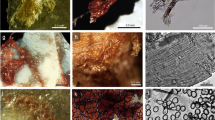Abstract
Witness marks produced on bone by the use of saws have traditionally been examined using stereomicroscopy. The marks are typically found on the kerf wall or floor and give important information about the implement that made them. This paper describes a new approach to the analysis of witness marks left on kerf walls and floors from crimes involving dismemberment. Previously, two types of marks have been identified: deep furrows formed during the pull stroke and fine striations formed on the push stroke. These types of striation allow the class of saw to be identified, but not an individual saw. With the advent of environmental scanning electron microscopy (ESEM), insulating materials can now be examined without the need for conductive coatings to be applied. This allows materials to be examined at higher magnifications than those available with stereomicroscopy. Here we report on a new, third type of striation that is visible at higher magnifications on ESEM images. These striations are formed from the imperfections on the cutting teeth of saws and give real possibilities of uniquely identifying whether or not a particular saw was used to cause the mark. In blind trials conducted on sawing of nylon 6.6, different individual saws could be successfully identified even if different people used the saw. We discuss ways in which these results can be extended to bone and how this may assist in the investigation of the act of dismemberment.









Similar content being viewed by others
References
Reichs KJ (1998) Postmortem dismemberment: recovery, analysis and interpretation. In: Reichs KJ (ed) Forensic osteology-advances in the identification of human remains. Charles C Thomas, Springfield, pp 353–388
Symes S (1998) Morphology of saw marks in human bone: introduction and examination of residual kerf contour. In: Reichs KJ (ed) Forensic osteology, advances in the identification of human remains. Charles C Thomas, Springfield, pp 389–409
Andahl RO (1978) The examination of saw marks. J Forensic Sci Soc 18:31–46
Bonte W (1975) Tool marks in bones and cartilage. J Forensic Sci 20:315–323
Weaver JK (1966) The microscopic hardness of bone. J Bone Joint Surg Am 48(2):273–288
Zysset PK, Guo XE, Hoffler CE, Moore KE, Goldstein SA (1999) Elastic modulus and hardness of cortical and trabecular bone lamellae measured by nanoindentation in the human femur. J Biomech 32(10):1005–1012
Katterwe H (1996) Modern approaches for the examination of toolmarks and other surface marks. Forensic Sci Rev 8(1):46–72
Reilly D, Burstein AH (1974) The mechanical properties of cortical bone, a review article. J Bone Joint Surg Am 56(5):1001–1022
Rho JY, Kuhn-Spearing L, Zioupos P (1998) Mechanical properties and the hierarchical structure of bone. Med Eng Phys 20(2):92–102
Burd DQ, Kirk PL (1942) Tool marks, factors involved in their comparison and use as evidence. J Crim Law Criminol 32:679–686
Acknowledgement
Mr. Graham Clark is thanked for his assistance with the ESEM.
Author information
Authors and Affiliations
Corresponding author
Additional information
The authors declare that they have no competing financial interests.
Rights and permissions
About this article
Cite this article
Saville, P.A., Hainsworth, S.V. & Rutty, G.N. Cutting crime: the analysis of the “uniqueness” of saw marks on bone. Int J Legal Med 121, 349–357 (2007). https://doi.org/10.1007/s00414-006-0120-z
Received:
Accepted:
Published:
Issue Date:
DOI: https://doi.org/10.1007/s00414-006-0120-z




